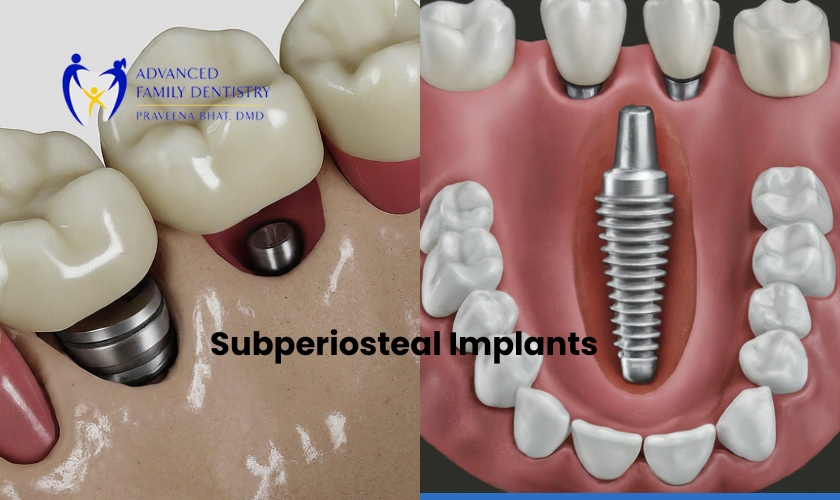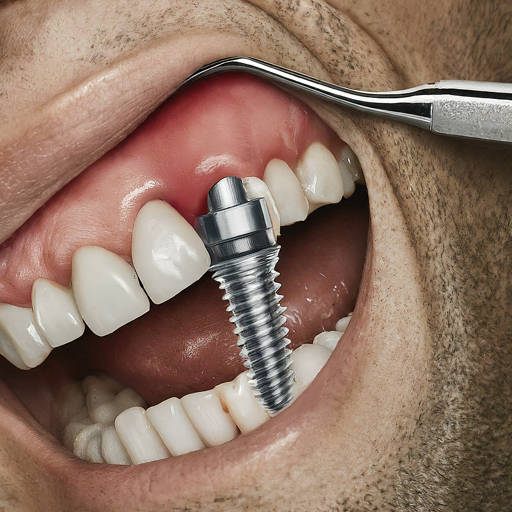Top Family, Cosmetic and Implant Center In 537 Amherst St, Nashua, NH 03063
When Would a Subperiosteal Implant be Recommended to a Patient?

Imagine a world where replacing missing teeth doesn’t require extensive jawbone surgery. For some patients struggling with tooth loss and bone loss, this dream becomes a reality with subperiosteal implants. But when exactly would a dentist recommend this unique implant option? Delve into this informative guide to discover if subperiosteal implants could be the missing piece to your complete smile.
Subperiosteal Implants
Missing teeth can significantly impact your smile, confidence, and even your ability to eat comfortably. Dental implants have revolutionized tooth replacement, offering a permanent and stable solution. But what if you have insufficient jawbone density to support these implants? This is where subperiosteal implants come into play.
Unlike traditional implants that are inserted directly into the jawbone, subperiosteal implants rest on top of the jawbone, secured by small posts that protrude through the gum tissue. These custom-made metal frameworks then support a fixed or removable denture, restoring both aesthetics and functionality.
Differences Between Subperiosteal and Endosseous Implants
| Feature | Subperiosteal Implants | Endosseous Implants |
| Placement | Rests on top of the jawbone | Placed directly within the jawbone |
| Ideal Candidate | Patients with insufficient bone density | Patients with healthy jawbone |
| Bone Grafting | Usually not required | May be required for insufficient bone volume |
| Procedure Time | Generally shorter | May be longer due to potential bone grafting |
When Would a Subperiosteal Implant be Recommended to a Patient?

While subperiosteal implants offer a valuable option, they aren’t a one-size-fits-all solution. Dentists consider several factors before recommending this procedure:
- Bone Loss: The primary reason for considering subperiosteal implants is inadequate jawbone density. This bone loss can occur due to:
- Periodontal disease: This gum infection can damage the jawbone supporting your teeth.
- Trauma: Injuries to the face or jaw can lead to bone loss.
- Resorption after tooth loss: When teeth are missing, the jawbone naturally begins to deteriorate over time.
Studies show that periodontal disease is a leading cause of bone loss in adults. A 2018 research paper published in the Journal of Clinical and Diagnostic Research suggests that nearly 65% of adults over 30 suffer from some form of periodontal disease. This highlights the potential need for alternative implant solutions like subperiosteal implants for patients with compromised bone health.
- Overall Health: Generally, patients in good overall health are ideal candidates for any implant surgery. Pre-existing medical conditions or weakened immune systems could increase the risk of complications.
- Age: Since jaw development ceases in adulthood, subperiosteal implants are a viable option for mature patients.
- Denture Needs: Subperiosteal implants are typically used for replacing multiple teeth, particularly in the back of the mouth, and can support fixed or removable dentures.
What is the Success Rate of Subperiosteal Implants?
With proper care and placement, subperiosteal implants boast a high success rate. A study published in the National Institutes of Health (NIH) database found a success rate of around 85% for subperiosteal implant procedures over a five-year period. However, this rate can vary depending on factors like the patient’s overall health, oral hygiene practices, and the dentist’s experience.
What are the Complications of Subperiosteal Implants?
As with any surgery, subperiosteal implants carry some potential risks:
- Infection: Proper hygiene and following post-operative instructions are crucial to minimize infection risk.
- Bleeding: Some minor bleeding is normal after surgery. However, excessive bleeding should be reported to your dentist immediately.
- Discomfort: Swelling and discomfort are common after surgery. Pain medication can help manage these symptoms.
- Implant Failure: While rare, in some cases, the implant framework might not integrate properly with the jawbone, leading to implant failure.
- Difficulty with Speech: During the healing period, while wearing temporary dentures, some patients might experience slight speech difficulties.
Benefits of Subperiosteal Implants
For qualified patients, subperiosteal implants offer several advantages:
- Reduced Surgical Intervention: By avoiding bone grafting procedures, subperiosteal implant placement can be a less invasive surgery, leading to a faster recovery time.
- Improved Function: Secured dentures provide superior stability and chewing ability compared to traditional dentures, allowing you to enjoy a wider variety of foods with confidence.
- Enhanced Confidence: A complete smile with a secure fit can significantly boost confidence and overall quality of life.
Regaining Your Smile with Subperiosteal Implants
If you’re struggling with tooth loss and insufficient bone density, subperiosteal implants offer a promising solution. By providing a stable foundation for dentures, these implants can enhance your smile, improve your ability to eat comfortably, and boost your confidence. However, consulting with a qualified dentist Nashua is crucial to determine if you’re a suitable candidate for this procedure. They will assess your individual situation, jawbone health, and discuss all available treatment options to find the best fit for your needs.
FAQs
Subperiosteal implants have shown to have a long lifespan, with proper care and maintenance. On average, they can last 10-15 years or more.
While subperiosteal implants offer advantages in certain scenarios, they may not be suitable for every patient. Factors such as bone quality, overall health, and anatomical considerations influence candidacy.
Like any dental procedure, discomfort during and after subperiosteal implant placement can vary from patient to patient. However, local anesthesia and sedation options are typically employed to ensure patient comfort throughout the process.
The cost of subperiosteal implants can vary depending on factors such as the complexity of the case, the number of implants needed, and geographical location. Patients should consult with their dentist or prosthodontist for personalized cost estimates.
Studies have reported high success rates for subperiosteal implants, with success rates exceeding 90% in many cases. However, individual outcomes may vary, and proper oral hygiene and routine dental care are essential for long-term success.




